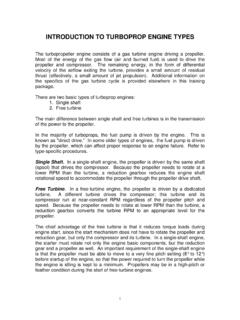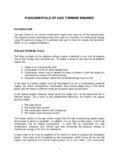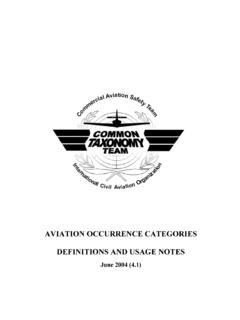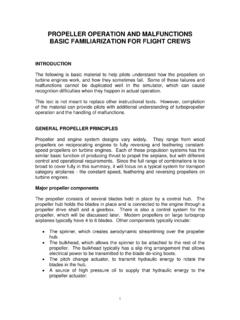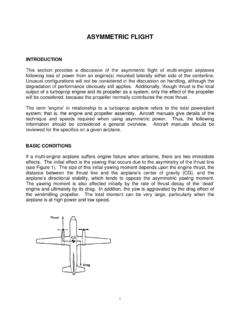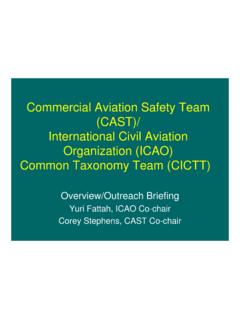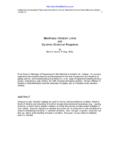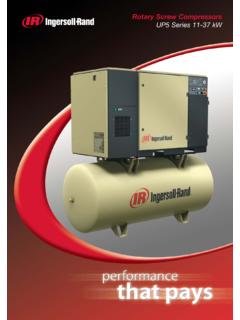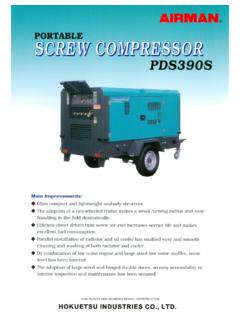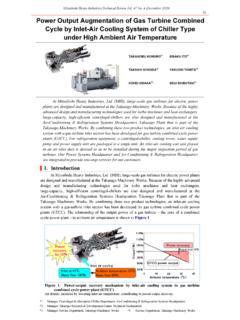Transcription of AIRPLANE TURBOPROP ENGINES BASIC …
1 1 AIRPLANE TURBOPROP ENGINES BASIC FAMILIARIZATION INTRODUCTION Many of today's airplanes are powered by TURBOPROP ENGINES . These ENGINES are quite reliable, providing years of trouble-free service. However, because of the rarity of TURBOPROP engine malfunctions, and the limitations of simulating those malfunctions, many flight crews have felt unprepared to diagnose engine malfunctions that have occurred. The purpose of this text is to provide straightforward material to give flight crews the basics of AIRPLANE engine operational theory. This text will also provide pertinent information about malfunctions that may be encountered during the operation of TURBOPROP -powered airplanes . It is not the purpose of this text to supersede or replace more detailed instructional texts or to suggest limiting the flight crew's understanding and working knowledge of AIRPLANE turbine engine operation and malfunctions to the topics and depth covered here.
2 Upon completing this material, flight crews should understand that some engine malfunctions can feel and sound more severe than anything they have ever experienced; however, the AIRPLANE is still flyable, and the first priority of the flight crew should remain "fly the AIRPLANE ." PROPULSION Figure 1 showing balloon with no escape path for the air inside. All forces are balanced. Propulsion is the net force that results from unequal pressures. Gas (air) under pressure in a sealed container exerts equal pressure on all surfaces of the container; therefore, all the forces are balanced and there are no forces to make the container move. 2If there is a hole in the container, gas (air) cannot push against that hole and the gas escapes. While the air is escaping and there is still pressure inside the container, the side of the container opposite the hole has pressure against it. Therefore, the net pressures are not balanced and there is a net force available to move the container.
3 This force is called thrust. The simplest example of the propulsion principle is an inflated balloon (container) where the stem is not closed off. The pressure of the air inside the balloon exerts forces everywhere inside the balloon. For every force, there is an opposite force, on the other side of the balloon, except on the surface of the balloon opposite the stem. This surface has no opposing force since air is escaping out the stem. This results in a net force that propels the balloon away from the stem. The balloon is propelled by the air pushing on the FRONT of the balloon. Figure 2 showing balloon with released stem. Arrow showing forward force has no opposing arrow. The simplest propulsion engine The simplest propulsion engine would be a container of air (gas) under pressure that is open at one end. A diving SCUBA tank would be such an engine if it fell and the valve was knocked off the top. The practical problem with such an engine is that, as the air escapes out the open end, the pressure inside the container would rapidly drop.
4 This engine would deliver propulsion for only a limited time. The turbine engine A turbine engine is a container with a hole in the back end (tailpipe or nozzle) to let air inside the container escape and, thus, provide propulsion. Inside the container is turbomachinery to keep the container full of air under constant pressure. A TURBOPROP engine extracts energy from the escaping air to drive a propeller. 3 Figure 3 showing our balloon with machinery in front to keep it full as air escapes out the back for continuous thrust. COMPONENTS OF A TURBINE engine The turbomachinery in the engine uses energy stored chemically as fuel. The BASIC principle of the AIRPLANE turbine engine is identical to any and all ENGINES that extract energy from chemical fuel. The BASIC 4 steps for any internal combustion engine are: 1. Intake of air (and possibly fuel). 2. Compression of the air (and possibly fuel).
5 3. Combustion, where fuel is injected (if it was not drawn in with the intake air) and burned to convert the stored energy. 4. Expansion and exhaust, where the converted energy is put to use. These principles are exactly the same ones used to make a lawn mower or automobile engine run. In the case of a piston engine , such as the engine in a car or lawn mower, the intake, compression, combustion, and exhaust steps occur in the same place (the cylinder head) at different times as the piston goes up and down. In the turbine engine , however, these same four steps occur at the same time but in different places. As a result of this fundamental difference, the turbine has engine sections called: 1. The inlet section 2. The compressor section 3. The combustion section 4. The exhaust section. The practical axial flow turbine engine The turbine engine in an AIRPLANE has the various sections stacked in a line from front to back.
6 As a result, the engine body presents less drag to the AIRPLANE as it is flying. The air enters the front of the engine and passes essentially straight through from front to back. On its way to the back, the air is compressed by the 4compressor section. Fuel is added and burned in the combustion section, then the air is exhausted through the exit nozzle. The laws of nature will not let us get something for nothing. The compressor needs to be driven by something in order to work. Just after the burner and before the exhaust nozzle, there is a turbine that uses some of the energy in the discharging air to drive the compressor and most importantly for propulsion the propeller. There is a long shaft connecting the turbine to the compressor ahead of it, and the propeller at the front. Propeller compressor combustor turbine nozzle Figure 4 showing the BASIC layout of a TURBOPROP propulsion system.
7 Machinery details From an outsider's view, the flight crew and passengers rarely see the actual engine . What is seen is a large elliptically-shaped pod hanging from the wing or attached to the AIRPLANE fuselage toward the back of the AIRPLANE . This pod structure is called the nacelle or cowling. The engine is inside this nacelle. The propeller is outside the front end of the nacelle, and the air passes through the propeller first. Most of the air is driven back by the propeller outside the engine nacelle; it never encounters the rest of the engine . The air near the propeller hub flows back to encounter the inlet cowl. The purpose of the inlet cowl is to direct the incoming air evenly across the inlet of the engine . The shape of the interior of the inlet cowl is very carefully designed to guide this air. The first component that air encounters on its way through an AIRPLANE turbine engine is the compressor .
8 The compressor of an AIRPLANE turbine engine has quite a job to do. The compressor has to take in an enormous volume of air and compress it to 1/10th or 1/15th of the volume it had outside the engine . This volume of air must be supplied continuously, not in pulses or periodic bursts. 5 The compression of this volume of air is accomplished by a rotating disk containing many airfoils, called blades, set at an angle to the disk rim. Each blade is close to the shape of a miniature propeller blade, and the angle at which it is set on the disk rim is called the angle of attack. This angle of attack is similar to the pitch of a propeller blade or an AIRPLANE wing in flight. As the disk with blades is forced to rotate by the turbine, each blade accelerates the air, pumping the air behind it. The effect is similar to a household window fan. After the air passes through the blades on a disk, the air will be accelerated rearward and also forced circumferentially around in the direction of the rotating disk.
9 Any tendency for the air to go around in circles is counterproductive, so this tendency is corrected by putting another row of airfoils behind the rotating disk. This row is stationary and its airfoils are at an opposing angle. Figure 5 showing compressor rotor disk. What has just been described is a single stage of compression. Each stage consists of a rotating disk with many blades on the rim, called a rotor stage, and, behind it, another row of airfoils that is not rotating, called a stator. Air on the backside of this rotor/stator pair is accelerated rearward, and any tendency for the air to go around circumferentially is corrected. A single stage of compression can achieve perhaps :1 or :1 decrease in the air's volume. Compression of the air increases the energy that can be extracted from the air during combustion and exhaust (which provides the thrust). In order to achieve the 10:1 to 15:1 total compression needed for the engine to develop adequate power, the engine is built with many stages of compressors stacked in a line.
10 Depending upon the engine design, there may be as many as 10 to 15 stages in the total compressor . As the air is compressed through the compressor , the air increases in velocity, temperature, and pressure. Air does not behave the same at elevated temperatures, pressures, and velocities as it does in the front of the engine before it is compressed. In particular, this means that the speed that the compressor rotors must have at the back of the compressor is different than at the front of the compressor . If we had only a few stages, this difference could be 6ignored; but, for 10 to 15 compressor stages, it would not be efficient to have all the stages rotate at the same speed. Figure 6 showing 9 stages of an axial compressor rotor assembly. The most common solution to this problem is to break the compressor in two. This way, the front 4 or 5 stages can rotate at one speed, while the rear 6 or 7 stages can rotate at a different, higher, speed.
